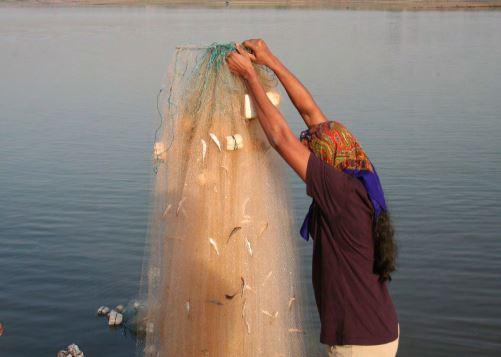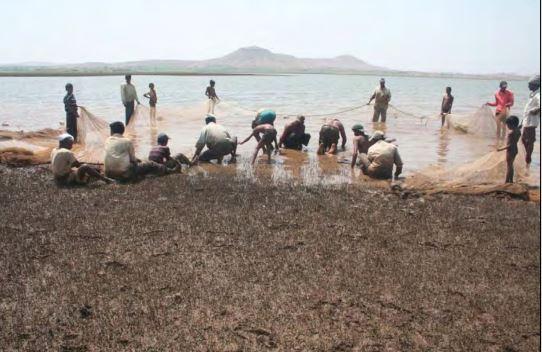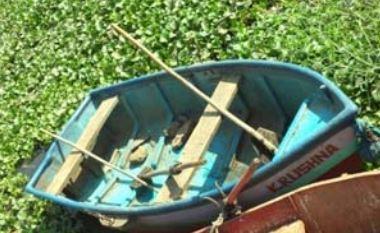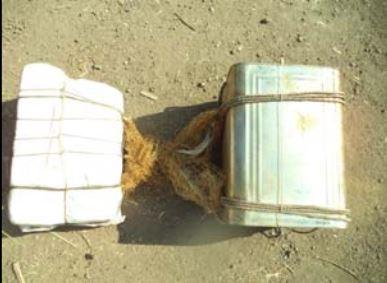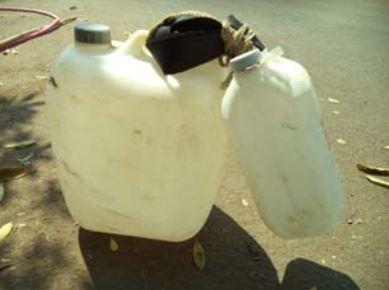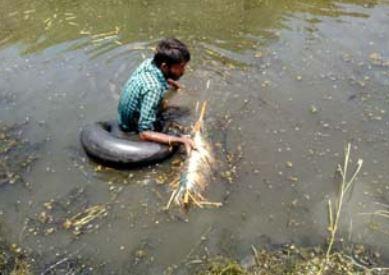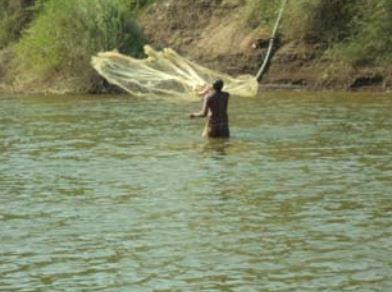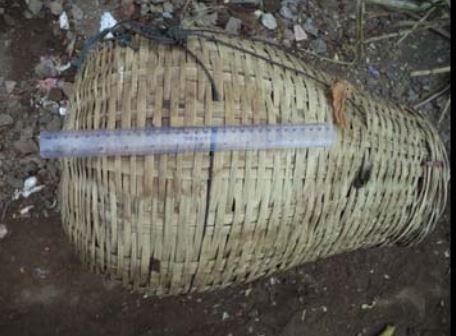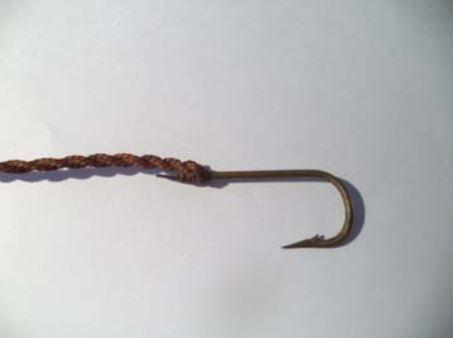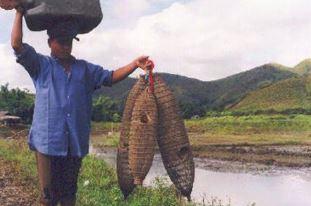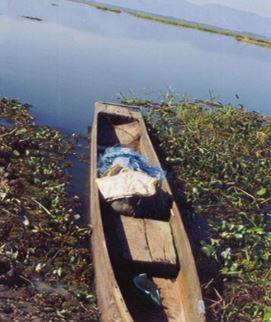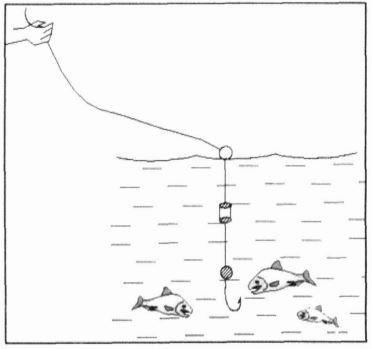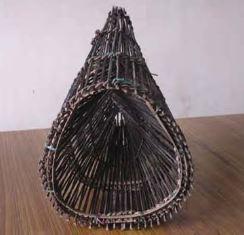Riverine Fishing Crafts and Gears
Riverine Fishing Crafts and Gears
Fishing crafts and gears in Godavari river
Fishing crafts
Thermocol Boat
The thermocol raft is also used to capture fishes in the rivers. This is made of two to three thermocol pieces tied together and used only for laying and hauling the fishing gears such as the gill net, castanet and angling.
Motor vehicle tubes
Inflated tubes of motor vehicles are used in the Godavari in Maharashtra for fishing purposes.
Hodi Boat
Those who do fishing in rivers for larger size fishes mainly use this. Typically, this kind of boat is operated by two fishers and primarily owned by full-time fishermen. It is also used to transport nets and family belongings when the fishermen migrate to the other areas by rivers. However, at present, it is rarely used due to shallow nature of the rivers.
Gears
The gill nets, seines, cast nets, drag nets and several miscellaneous types of gear are used in Godavari. It varies due to target species and prevailing condition of the river.
Gill net
It is made of the multifilament gill net and is practiced in the entire river course of Godavari. It is used round the year except for monsoon season. The mesh size ranges between 12 to 50mm.
Seine
Around ten persons operate the larger seine and two to three persons operate a small seine net. In the earlier years, carps, catfishes, and miscellaneous species formed the dominant catch, while in recent years, miscellaneous fishes and prawns account for the major portion of the catch. It was a popular gear, but its operation has come down significantly in recent years. In a study at Gangapur dam, the presence of giant prawns was seen, while at Raher, large specimens of catla weighing 8 to 10 kg were seen.
Cast net
It is the most common fishing gear operated through the entire river course. Almost each angler owns a cast net to exploit prawns and small fishes. Few units with bigger mesh (15-20 cm) exploit large carps.
Fishing gears in Krishna River
Coracle
Coracles are normally used throughout the river. A modified version of coracle is fabricated with galvanised plates. Internal diameter ranges between two to three meters with an inner depth of about 0.5 m. Besides being simple and inexpensive, coracle is durable and has very good movability in all types of waters. It is also a versatile craft used for laying and lifting of nets, besides navigation and transport of fish and other materials. Weight of the Coracles ranges from 10-l5 kg. Usually, two fishermen carry out fishing from a coracle. Like other canoes, oars are used for propulsion.
Fibre glass boat
It is the most common fishing crafts employed in different stretches of the river. The fishing boat length ranges from three to five metres with a breadth of 1 – 1.5 m.
Thermocol raft
Slices of thermocols are tied with rope to make a bundle of length 0.4 – 0.5m with a diameter of 0.2-0.3 m. Two such bundles are tied with rope on which fishers used to seat and go for fishing. Similarly, the thermocol raft is used during drag net operation.
Plastic cans
The empty or ordinary plastic cans are also used for fishing which is having the capacity of 5 – 10 L. Two such cans are tied together using a piece of rope or cloth with 1 ft distance kept between two cans. During fishing, the cans are placed between legs, one in the front and other in the back. Since the upper part of the body remains above water, fishers can operate the net and paddle some distance.
Rubber tube platform
In some stretch of river, the fishermen rely on other kinds of improvised materials. They show considerable ingenuity in fabricating makeshift out of discarded old rubber tubes. A wooden platform 1 sq.m. area is placed over the rubber tube and tied tightly with rope. It is mostly used in Takari station for hook and line operation and also setting and hauling of gill nets.
Gill net
Different mesh size gill net is used in this river, and there is no mesh size regulation to get rid of juveniles except in Nagarjuna Sagar dam. The greater size fishes landing is found wherever the larger mesh size is used. The yellow colour gill net has resulted in greater quantity of landing when compared to all other kinds of gill net colour. A larger size gill net has ~500 m in length.
Cast net
It is the most commonly practiced gear throughout the river. The obvious reason is that it can be operated single-handed. Different mesh and pocket size are used to target particular species.
Drag Net
It is comparatively less in use as it requires significant man power, plain terrain and relatively low water level. Below Prakasam barrage, the river has a depth of 0.5 - 2 m, where frequent dragnet operations are observed.
Push net
It is made of a triangular bamboo frame fitted with a mosquito netting cloth (1/14'' mesh). Fishermen operate it first by pushing the net and then scooping from the water to catch the seeds of tiger prawn, P. monodon. A single fisherman generally goes with two such nets. Big one (1.5-2 m arm length) is used to catch prawns and small one (~1 m arm length) is used to cover the mouth of a floating vessel where the catches are preserved in living condition to be used for stocking. The triangular shape of this small net balances perfectly to keep the vessel erect. It is used in the Umbroj, Karad and Haripur to catch prawns.
Lantern net
This cone shaped net is observed in Amudharlanka. Kerosene gas pressure lamp with incandescent mantle is used to attract the fishes. When the fishes are near the base of the light, it is caught by casting the net on stunned fish as the river is shallow (0.5-1.0 m). The rod above (~1.2 m) is used as a handle to operate it like a dart. Fish is trapped inside the conical net tied with the hoop (diameter 0.3-0.4 m) and is caught. Though individual catches per operation are small (one or two Etroplus), it takes less time and effort.
Box trap
Among different fishing traps, box trap is one of the major gears used in prawn fishery in river Krishna. Trap fishery works on the principle of allowing the fish to enter the trap and then preventing their escape from the trap. Box trap is a cube shaped trap made of bamboo sticks knitted with some durable creepers. A bicuspid non-returning uni-directional vertical valve along the height of the trap is made as an entrance for fishes. The sticks used to make this valve is thinner and knitted with nylon rope. The trap is kept in a vertical position under the water facing the water current. A thermocol float is tied with the trap with cotton wire to help in locating the position of the trap. A piece of coconut kept inside the trap is used as bait to lure the prawns. Though mostly prawns are caught, Notopterus or Etroplus are also trapped.
Hook line
Hook line is also used throughout river Krishna. This is rampant at Satrasala, a deep pool of 16-18 m, around 10 km below Nagarjunasagar dam and at Thummalapalem, 15 km above Prakasam barrage, due to higher water level and less flow. Using earthworm as living bait and snail-flesh as dead bait fishermen catch prawns (M. malcolmsonii) from the river.
Fishing methods of Northeast of India
Fishing crafts are needed to negotiate through the water for operating fishing gear in deeper waters. There are three types of fishing crafts operated in the water bodies of North-Eastern India.
Bamboo Raft
It is cheap and easily made craft used by poor fishers since bamboo is abundantly available in the region. About 20-50 light weight variety bamboos (e.g., Jati) are tied together (keeping all the bigger ends of the trunks towards the stern side) with coir/jute ropes for constructing this raft. This craft is usually 1 – 12m in length with a width of 1.5 – 5m. The size depends on the water current and number of bamboo used. This draft is heavy to push through water (done with the help of bamboo poles) and have the average life span of 1 – 2 years. This is normally used in the sluggish river.
Dug-out Canoe
These all are small wooden canoes dugout from a single log of tree. The length of the boat is about 3 – 4m with a width of 0.5 – 0.6m. Trunks of Palm tree are also occasionally used to make smaller canoes. It is operated by only two fishermen because it is smaller in size and also lot of rolling movement requiring skilling to maneuver them.
Plank-built Boat
This is the most advanced fishing craft used in the region. These spindle shaped boats are constructed by joining planks of good quality timber with iron nails. The boat is painted with coal tar to make joint leak proof and extend the life of boat. These boats vary in shape and size and depends on where it is being operated. Small size boats (4 – 6 m in length; 0.8 – 1.0m width) are operated in the floodplain wetland, and the bigger size (7 – 8m length; 1.2 – 1.8m width) are operated in the rivers. These boats are generally manually propelled.
Hooks and lines
In this method, a rod is tied with indigenous fiber or cotton thread or nylon twine and the end is fixed to a hook. The bait used to attract the fish may be an earthworm, nymph of beetle, smaller fish or small frogs or artificial bait made up of rice bran or wheat flour. The line may be made up of indigenous fiber or cotton thread or nylon thread. This line may be attached to a pole (pole and line), which is bamboo or other locally available twinge. If there is no pole, then it is called hand line. A sinker or float may or may not be there. There are many types of hooks and lines like short hand line, long hand line, pole and line, etc. The method is practiced as a leisure time hobby by most local individual in most of the rivers.
Trap fishing
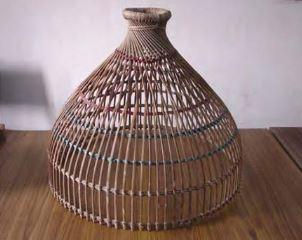
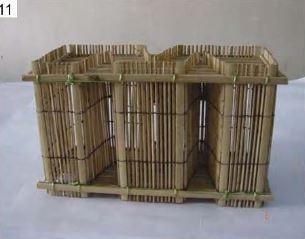
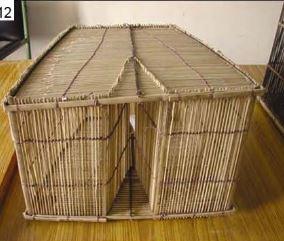
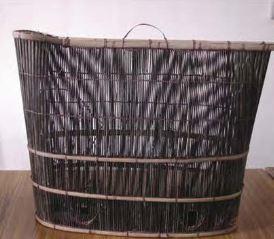
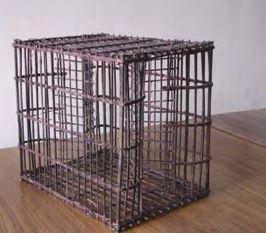
This method is very common because it is less time consuming and less maintenance is required and no physical attendant is needed. This is operated for a long time and operational time of the traps is different and may last for more than one week depending on the design, season and place of the operation. The traps are so designed that once the fish is entered it can not escape. Various names are given to different designs of traps.
Maze/barricade
The maze or barricade is a bamboo trap of various designs. The principle of the method is to trap the fish in a cage made generally of split bamboo. Once entered, the fish cannot escape from the trap. Sometimes, to lure the fish baits are kept inside the trap. This method is very common in this region as it does not need to guard the traps; they simply put the trap in a specific location and pull out after some time or some days. There are various shape and size of bamboo maze used in this region and their name varies with different locations. The shape may be of conical, cylindrical or basket type.
Arial trap
By this method, migratory fishes are caught on their way. Some kind of obstacle is put on the path of the migratory fishes and when the fish face the obstacle, they jump out of the water and fall in the traps. The traps may in the form of pit or bamboo stick knitted with threads kept in the way.
Encircling gear
This includes all types of nets used to capture fish by placing a mobile net to block the escape. Cast net made up of cotton or nylon twine or indigenous fiber is one such gear commonly used in the hill streams of this region.
Entangling gear
These are used to catch a great variety of fishes and are very common in the Northeast region. The fishes get caught in it by the gills. The net may be of nylon or made from an indigenous fiber having various maze sizes to catch specific fish. Such devices are becoming increasingly popular.
Impaling gear
This is a form of gear by which a fish is impaled by a sharp device. The basic principal of the method is to make the fish wounded using some device like harpoons, spears, knife, sickle, etc. The device can only be employed when the fish is plainly visible. There are various types of the gears and name of the devices changes according to the location.
Scooping gear
Scooping nets are usually operated in the shallow waters for capturing small fishes. The net is usually made of cotton or indigenous fiber. In shallow water, scoop baskets made up of bamboo are used.
Dragging gear
The net bags or nets are towed through the water. At least four individuals are required to do the job. It is done in winter when the water level decreases. The practice is commonly seen in slow moving rivers.
Lift net
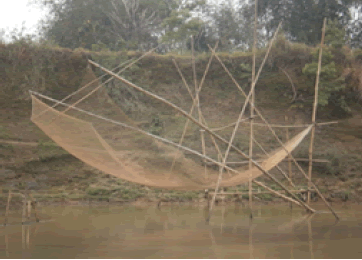
In this method, a square net is used, where four corners of the sheet are tied to the tips of a crossed flexible bamboo. A bamboo is attached to the point of crossing the flexible bamboo. The whole arrangement may or may not have a rope; when there is a rope to function then it is called a hand lift net and without a rope, it is called Chinese dip net. The device is mainly used in slow flowing rivers in the plain.
Electric fishing
Using some crude devices, an electric field is created in water to immobilize and collected fish. Current is passed through a naked wire/plate and the fishes are collected with hands or nets. This method is popular in most parts of Manipur.
Sources
- Bhattacharjya, B. K., R. K. Manna, and M. Choudhury. 2004. Fishing Crafts and Gear of North Eastern India (CIFRI Bulletin no. 142).
- Gurumayum, S.D. and Choudhury, M., 2009. Fishing methods in the rivers of Northeast India. Indian journal of Traditional Knowledge. 8: 237-241.
- Kokate, A.A., Bhosale, B.P., Metar, S.Y., Chogale, N.D., Pawar, R.A. and Nirmale, V.H. 2016. Indigenous fishing crafts and gears of Krishna River with respect to Sangli district of Maharashtra, India. International Journal of Fisheries and Aquatic Studies. 4: 434 – 438.
- Laxmappa B, Bakshi R. 2014. Types of fishing gears operating and their impact on Krishna river fishery in Mahabubnagar district, T.S. India International Journal of Fisheries and Aquatic Studies. 2(1):30- 41
- Manna, Das RK, Archan K, Krishna R, Karthikeyan M, Singh DN. 2011Fishing crafts and gear in river Krishna. Indian Journal of Traditional Knowledge. 10(3):491-497
- MPCB and CIFE 2011. Assessment of riverine fisheries and linking with water quality restoration programme – river Godavari in Maharashtra.
- Nath, P. and Dey, S.C, 1989. Fish and Fisheries of Northeastern India, Vol 1, (Arunachal Pradesh), 194. Rupam, S. 2001. Traditional fishing methods and fishing gears of Assam, Fishing Chimes, 20 (12): 23.
Last Modified : 7/1/2024
This topic gives the information about the fishing...
This topic gives the information about the fishing...
